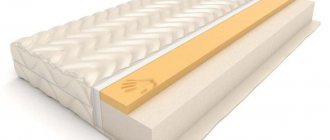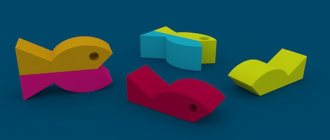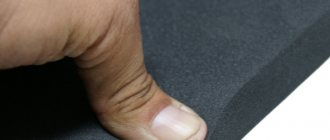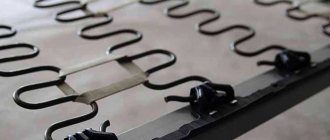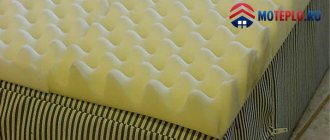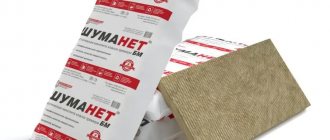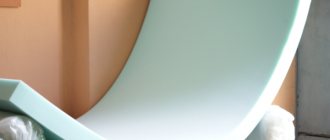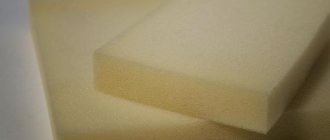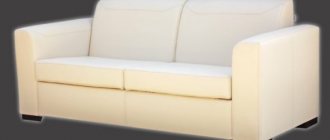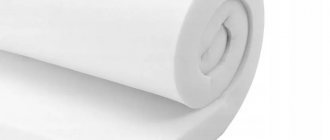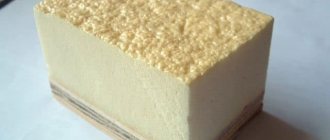Home / Opportunities / Molded polyurethane foam (FPPU)
Finished products from FPPU
Molds for polyurethane foam casting
Moscow Furniture Factory (MFM) uses molded polyurethane foam for the manufacture of seats and upholstered furniture. A separate workshop has a full cycle production, starting from the development and production of molds. The factory's clients have the opportunity to order or buy any blanks and products at an affordable price.
Purpose of molded foam rubber
The need to satisfy the new technological needs of furniture production gave rise to the invention of a new type of foam rubber - molded. In most cases, it is used to make car seats. This is necessary in order to ensure comfort during a long stay in the chair, and to ensure comfort during any side-to-side movements. In this case, any pressure at one point or completely on the surface of the product does not leave any traces:
- the shape of the seat remains the same even after a long stay in the chair;
- after many hours of work, the soft filler does not lose its shape, it remains just as soft and elastic;
- regardless of the consumer’s body constitution, the load on the surface is distributed evenly;
- It is more likely that the upholstery fabric will wear out than the molded filling itself.
To be honest, the use of such an expensive, but highest quality material in the furniture industry is nonsense. However, such pleasant exceptions still exist. It’s worth mentioning right away that foam rubber of persistent density and elasticity is in itself an expensive material. If we take into account the molded type of such material, then its cost increases several times. But this is not what should worry buyers who want to purchase a high-quality chair for their home or office.
Molded PU foam is made with a relatively higher percentage of latex than primary or secondary PU foam. This form is slippery to the touch, but pleasant.
Molded foam rubber has improved physical properties compared to other types of polyurethane foam. During the manufacturing process, its surface is covered with a special polyester crust, which guarantees the airtightness of the material, but improves its physical qualities. Of course, a number of characteristics are determined by the peculiarities and production techniques.
On the Ukrainian furniture production market it is difficult to find a manufacturer who would use such expensive materials.
Advantages of FPPU
Compared to other padding materials, molded polyurethane foam has significant advantages.
- The high density and springiness of the material provide increased comfort. Using molded polyurethane foam for furniture or mattresses, the manufacturer gives the product orthopedic properties.
- The ability to maintain shape even under significant loads is an important parameter for consumers. Armchairs, sofas, seats with such filling will not lose their shape even with active use.
- FPPU is environmentally friendly, has hypoallergenic properties and low thermal conductivity.
- When molding polyurethane foam, no waste is generated, which reduces production costs and the cost of products.
- Molded parts are precisely sized to reference dimensions because the process does not allow for deviations.
- Molded polyurethane foam lasts 3 times longer than traditional foam rubber. The material does not crumble and does not lose integrity over time.
Production Features
Molded foam rubber is the most advantageous wear-resistant material, the main weight component of which is polyester. The percentage of such a component determines the “airiness” and density of the finished product. Polyester is:
- Complex . Due to its qualities, the material is used, as a rule, for the production of filters and fire-resistant duplication (fabric and eco-leather are used). In the production of chairs, such foam rubber is not used for the reason that the moisture present in the room will gradually destroy the soft filling.
- Simple. This option is used and widely used for high-strength soft products for home and office, in particular for extra-class chairs.
Manufacturing technique
The production technique also differs in the method:
- Periodic . It is also called “box”. This method is the most commonly used and has a half-century history. The essence of production: foam is poured into separate boxes with partitions; After the foam has risen (like dough), the partitions are removed. The only peculiarity can be considered the difference between the foam rubber compartments.
- Continuous . Provides for the need for a conveyor along which the formed foam flows. This method makes it possible to obtain blocks of various lengths up to 60 m. This option is more effective because it produces less waste: approximately 1.5 m of the first batch is spoiled (foaming and the start of machine operation). The remaining batches are of ideal shape and identical consistency.
In Soviet times, there was only one elastic polyurethane foam on sale from Sweden, which was called “Porolon”. That’s why we call any flexible polyurethane foam used in the furniture industry – foam rubber.
Scope of application
Excellent performance characteristics make this material optimal for the production of upholstered furniture. Molded polyurethane foam can be used in models with or without embedded elements. Armchairs, sofas, seats with such filling have a higher level of comfort than traditional ones. This opens up broad prospects for the production of luxury furniture.
Strength, reliability, durability - the optimal parameters for arranging public places. Therefore, FPPU is used in the manufacture of seats for public transport, stadiums, arenas, and halls.
MFM offers its clients not only the production of finished products from molded polyurethane foam. If necessary, we will produce custom molds of the required configuration. It is also possible to manufacture soft structural elements for various purposes: buffer, decorative, etc.
You can get more detailed information and free personal consultation from our specialists. Contact us by phone or email listed on the website - and we will advise you on the best option for you!
Molded foam rubber (FPPU) in the production of soft chairs
Since the technical properties and wear resistance qualities of molded foam rubber differ from other types of polyurethane foam, the technique of its use in the manufacture of chairs also differs. In the following articles we will talk about what a “foam rubber sandwich” is, and at this stage, we should understand the features of using a more advanced material - molded polyurethane foam or FPPU.
The peculiarity of using such material is the absence of constructive technologies that are difficult to implement. All that is required is to select the desired shape of the anatomical FPPU and attach it to the frame base of the seat. No other material is placed on top of the FPPU, but everything is simply covered with dense material, creating visual appeal.
A clear example of the quality of the synthesis of new technologies and innovative developments is presented in the Barsky models:
- Armchair Barsky Eco.
- Butterfly.
- Barsky Style.
These options will not only last 7-10 years, but will also look equally attractive all this time.
Today, molded foam rubber is a new technological development that is popular in the production of car furniture. However, the advantages of elastic material did not go unnoticed by the Ukrainian manufacturer Barsky. Today you can buy a chair with anatomical memory and high wear-resistant properties in Ukraine directly from the manufacturer. You will get tired of the design of the chair faster after several decades than it will have time to wear out.
Polyurethane foam (“foam rubber”), including with “shape memory” (Memory Foam)
Elastic polyurethane foam (furniture PU foam) is used in the production of mattresses. It comes in different hardnesses; spring mattresses use soft PU foam; springless mattresses also use medium hardness and hard PU foam as the base of the mattress (monolithic block). The most inexpensive among all fillers in mattresses, although in mattress production various types of polyurethane foam are used, differing in quality, maximum load and, accordingly, service life, including expensive and high-quality types of polyurethane foam (artificial latex, memory foam material), which in their own way properties and quality are not inferior even to natural latex. A good feature of this material is its good breathability, thanks to its porous structure.
Foam rubber is the trade name for elastic polyurethane foam, which in the Soviet Union was mainly produced by the Scandinavian company Porolon.
Polyurethane foam (PPU) is an artificial cellular filler (visually comparable to a sponge), it is a proven and safe material, which confirms its widespread use in everyday life, for example: sponges for washing dishes, filler in car seats, insulation in construction. Polyols are used as the main raw material for the production of polyurethane foam; when the polyol and a number of modifying catalysts are mixed, a chemical reaction occurs, as a result of which the mixture foams. Due to different dosing of chemical products, different types of polyurethane foam are obtained.
Highly elastic polyurethane foam (artificial latex) is distinguished by improved properties of the raw materials used for production, as well as the structure of the cells. Unlike conventional elastic polyurethane foam, which has a uniform cell structure, highly elastic polyurethane foam has a heterogeneous structure, the cells have different sizes, wall thicknesses and are distributed in a random order. Due to the heterogeneous structure, at low loads, smaller cells come into operation, and when the load increases, larger cells, with greater compression resistance, come into operation. Therefore, highly elastic PU foams are characterized by high elasticity and comfort, as well as a longer service life.
The figure on the left shows the cell structure of ordinary polyurethane foam, on the right - highly elastic polyurethane foam.
Photo of a slab of ordinary polyurethane foam (height 3 cm), used as a filler in a mattress.
Photo of a monolithic block of highly elastic polyurethane foam (height 8 cm) called Waterform from the Italian mattress manufacturer Lordflex's, used as a base in a springless mattress.
Viscoelastic polyurethane foam with “shape memory” (other names: Memoryform, Memory Foam, Memorix) is an expensive and unique material with special physical and mechanical properties, characterized by slow recovery after compression. When an object (for example, a human body) is immersed in viscoelastic foam, the foam accurately reproduces the shape of the immersed body, and after the load is removed, the foam slowly returns to its original shape. Viscoelastic foam responds to body and ambient temperatures, softening with body heat and more easily molding to body contours. Due to this, the filler puts the least pressure on the subcutaneous vessels and promotes better blood flow. Due to its increased density and at the same time a high level of comfort, polyurethane foam with “memory” has low air permeability compared to conventional polyurethane foam. Other characteristics of viscoelastic foam are the ability to absorb vibrations and absorb shock - products made from viscoelastic foam absorb up to 90% of the impact energy. Viscoelastic polyurethane foam is used in many areas of industry, including the space industry (it was first used by NASA - the US National Aeronautics and Space Administration).
Photo of a slab of viscoelastic polyurethane foam with “memory” (height 4 cm) used as a filler in a mattress.
The photo shows an imprint of the shape of a hand after pressing on viscoelastic polyurethane memory foam - the effect lasts for several seconds.
Video about the production of furniture foam rubber at the Russian SIBPLAST plant:
More about polyurethane foam
When in the late 30s of the 19th century, that is, almost two hundred years ago, German physicists working for the Bayer concern worked on the development of polyurethane elastomers, they could not even imagine that the resulting final product containing unwanted gas bubbles would become a new step in the evolution of polymer materials. Scientists began to purposefully combine polyhydric alcohols with multifunctional isocyanates. This is how foam plastic with a cellular structure appeared. Subsequent experiments and experiments led to the formation of the final product - polyurethane foam.
In essence, polyurethane foam (PUF) is a mass-produced engineering plastic that can be used for a variety of purposes.
Different types of polyurethane foam are based on polyesters or polyesters (PE). Thus, based on complex PEs, in the middle of the last century, foam plastics with elastic properties began to be developed. A few years later, the first foams based on polyethers appeared. The scope of application of polyurethane foam gradually expanded, and by the end of the 90s, polyurethane foam was actively used everywhere. Moreover, about 70% of the total volume of polyurethane foam produced was used in the manufacture of upholstered furniture and mattresses.
When choosing a certain type of polyurethane foam for upholstered furniture, its main characteristics are important: degree of rigidity, weight, elasticity, shock-absorbing properties. All these qualities depend on what initial products and formulations are used in the production of polyurethane foam.
According to the degree of rigidity, elastic polyurethane foam can be super-soft (from 0.5 kPa), soft, standard or hard. There is also super-hard polyurethane foam (up to 10 kPa). Rigid polyurethane foam can replace spring blocks, and sheets of increased softness polyurethane foam of small thickness are usually used in combination with other materials.
There are two ways to produce elastic polyurethane foam. When making molded polyurethane foams, each part is molded separately. In the production of block polyurethane foam, the final product is large blocks of rectangular or cylindrical shape, which are then cut into blanks.
When choosing a specific type of block elastic polyurethane foam for the manufacture of upholstered furniture, concepts such as the rigidity of the material and its apparent density are of paramount importance. Stiffness is the ability of a material to resist deformation. The apparent density is determined by the volumetric weight of the porous material. Stiffness and apparent density are closely interrelated: the higher the density of the material, the better the quality of the foam and the higher the limit of its “fatigue”. That is, the higher the load expected on a certain section of furniture, the higher the degree of apparent density should be. With a successfully adjusted combination of apparent density and rigidity of the material, high quality upholstered furniture can be achieved.
Practice shows that the following options for selecting polyurethane foam for various elements of upholstered furniture can be considered the most successful. For seats that experience constant high loads, the density of polyurethane foam should be no lower than 28-30 kg/cub.m. For armrests and backrests, which bear a much smaller load, you can use polyurethane foam with a slightly lower apparent density (23-25 kg/cubic meter). The highest degree of apparent density is required for polyurethane foam used in the manufacture of thin flooring in seats (at least 35 kg/cub.m.) and in backrests and armrests (at least 28 kg/cub.m.). The reason is that the thinner the flooring, the more susceptible it is to deformation.
The degree of elasticity of polyurethane foam is determined based on the area of the hysteresis loop under the influence of load. The smaller the loop, the more elastic the material, and, therefore, the faster it will return to its original shape after the load disappears. Block polyurethane foam has wide possibilities in terms of selecting the degree of elasticity. This allows you to combine materials of varying degrees of elasticity into floorings that exactly match the specified parameters.
Block elastic PU foam is especially good for making mattresses. The reason is the high breathability, excellent moisture and heat exchange, and low weight of this material. However, it should be remembered that the apparent density of the polyurethane foam used in the manufacture of the mattress should not be lower than 30-35 kg/cub.m. This is necessary so that the polyurethane foam cells do not deform and moisture and air exchange inside the product are not disrupted.
Block PPUs have a lot of advantages. They are durable as a material for making furniture (especially those developed on the basis of polyesters), resistant to aging, and resistant to moisture and temperature changes. In addition, block PU foams meet the highest sanitary and hygienic requirements. Numerous studies have proven the absolute safety of block PU foam for human health. The only drawback of block polyurethane foam (especially with a density less than 30 kg/cubic meter) that should be remembered is that the material may lose its original properties when recovering from excessive compression. This means that products containing block polyurethane foam should be stored and transported with special care.
Molded polyurethane foam is used in the manufacture of complex and voluminous upholstered furniture elements. Each part is produced in an individual mold. At the same time, the production accuracy is so high that it does not require further refinement. Parts made from molded polyurethane foam have a much higher density than parts made from block polyurethane foam with similar characteristics. The density of the material for the backs of sofas and armchairs is not less than 42 kg/cub.m, for seats - not less than 45-48 kg/cub.m. In office furniture, where the thickness of the soft element is very small and the requirements for wear resistance are quite high, polyurethane foam with a density of 55 - 70 kg/cubic meter is used.
Polyurethane foam has high adhesive ability to almost any material. With the molding method, it is therefore possible to use spring blocks, metal frames and other parts simultaneously with polyurethane foam. Thus, the process of manufacturing upholstered furniture is greatly simplified: in one operation you can get a completely finished unit.
Today, the main flooring material in the manufacture of upholstered furniture remains cheaper block polyurethane foam.
Additionally, you can read about the chemical structure and applications of polyurethane foam on Wikipedia.
